Opinion Editorial: Addressing Abuse of Women in Prison Through Nursing
VerifiedAdded on 2020/05/28
|8
|2208
|73
Essay
AI Summary
This opinion editorial addresses the pervasive issue of abuse against women in prisons, emphasizing the need for collective responsibility and the crucial role of the nursing profession. The essay highlights the vulnerability of female inmates and the challenges they face within a male-dominated environment, advocating for preventive actions and advocacy strategies to reduce violence. It proposes solutions such as gender equity training for male prisoners, community awareness initiatives, and the implementation of work and life skills programs. The editorial underscores the importance of changing the attitudes of prison staff, promoting the reporting of abuse, and ensuring the safety and dignity of women prisoners. The nursing profession is positioned as key to identifying abuse, educating others, and advocating for the common good of all individuals, including those incarcerated. The essay concludes by emphasizing the importance of advocacy and community engagement strategies to address the challenges in realizing the aspirations of the common good in women prisoners.
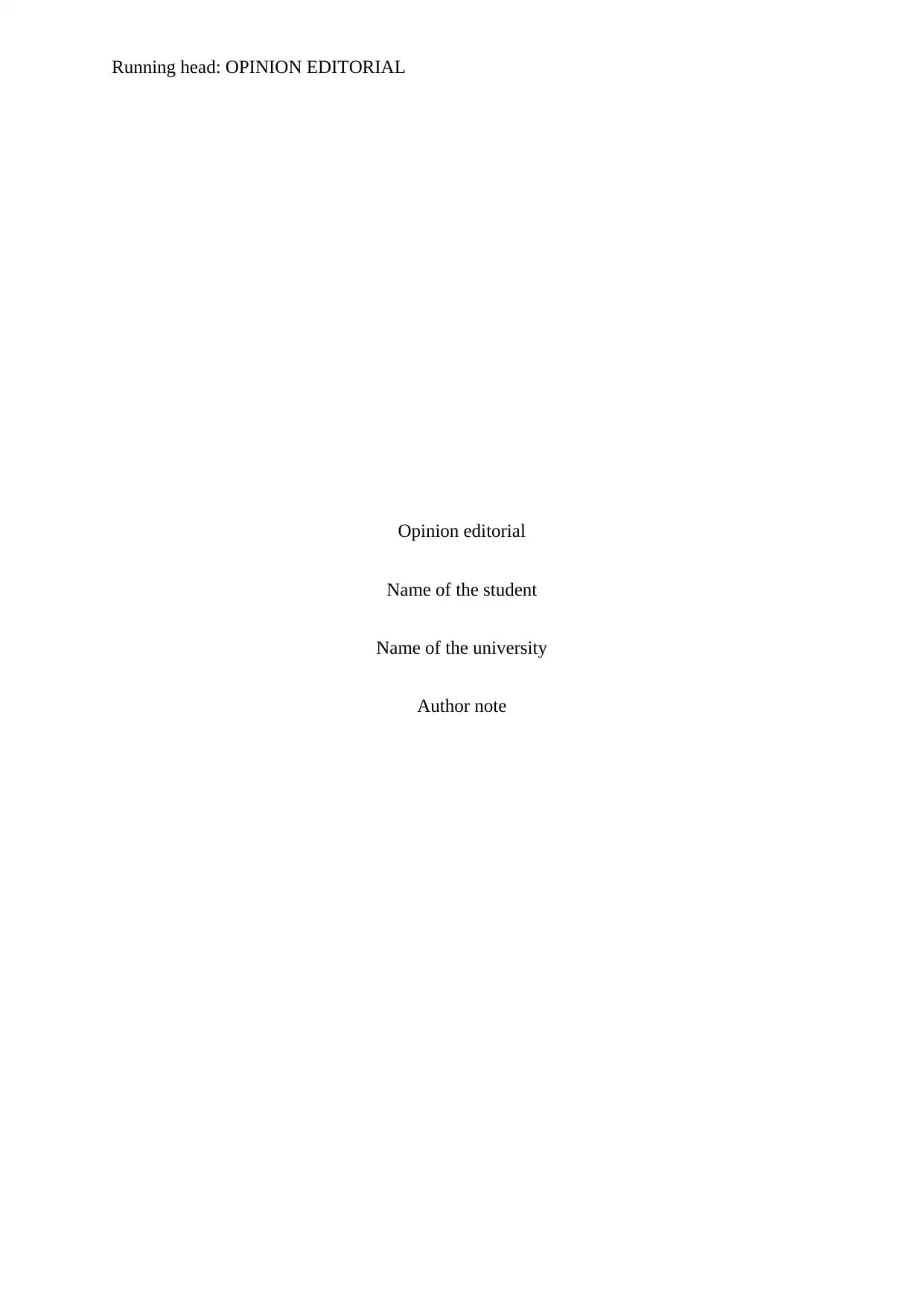
Running head: OPINION EDITORIAL
Opinion editorial
Name of the student
Name of the university
Author note
Opinion editorial
Name of the student
Name of the university
Author note
Paraphrase This Document
Need a fresh take? Get an instant paraphrase of this document with our AI Paraphraser
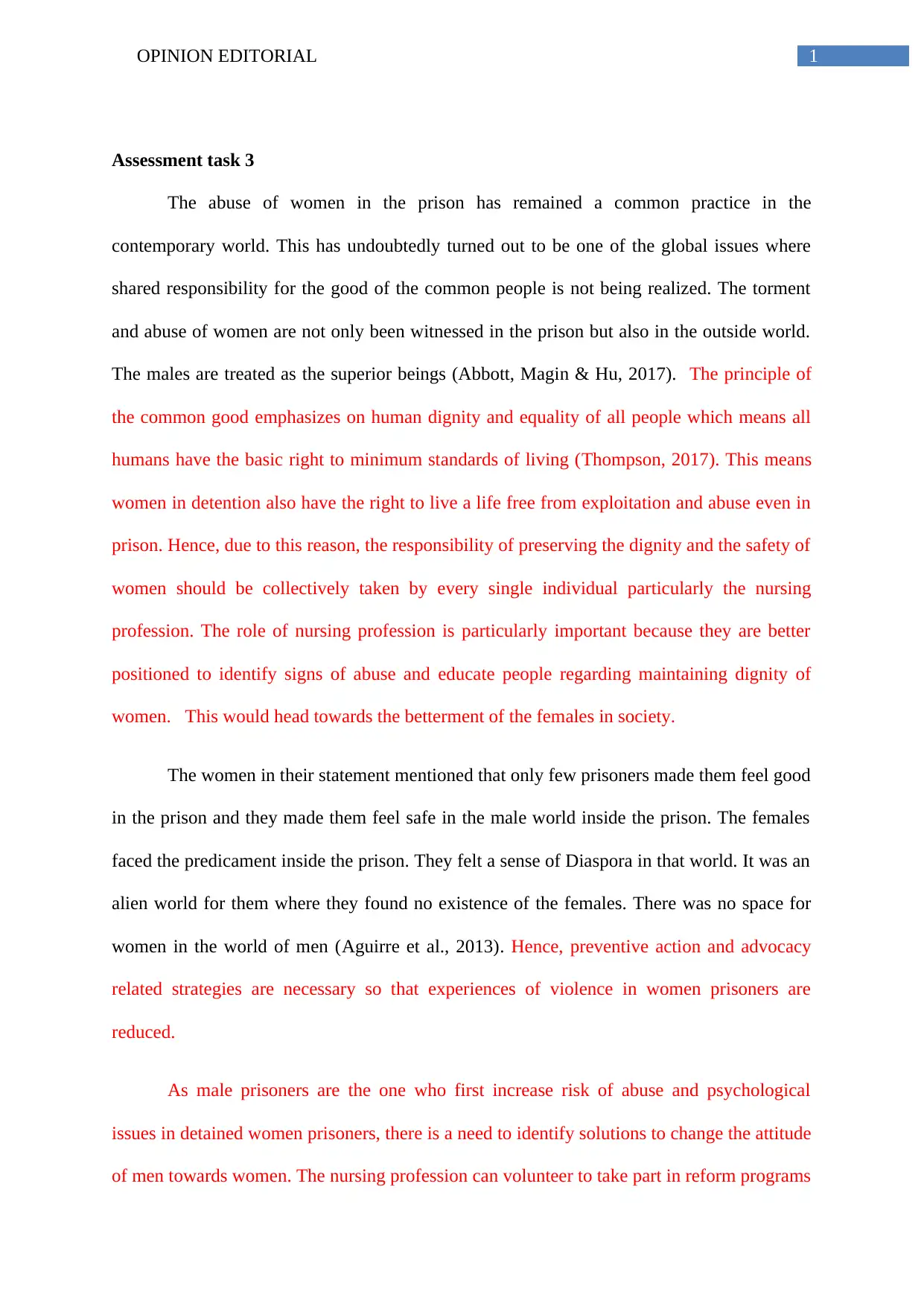
1OPINION EDITORIAL
Assessment task 3
The abuse of women in the prison has remained a common practice in the
contemporary world. This has undoubtedly turned out to be one of the global issues where
shared responsibility for the good of the common people is not being realized. The torment
and abuse of women are not only been witnessed in the prison but also in the outside world.
The males are treated as the superior beings (Abbott, Magin & Hu, 2017). The principle of
the common good emphasizes on human dignity and equality of all people which means all
humans have the basic right to minimum standards of living (Thompson, 2017). This means
women in detention also have the right to live a life free from exploitation and abuse even in
prison. Hence, due to this reason, the responsibility of preserving the dignity and the safety of
women should be collectively taken by every single individual particularly the nursing
profession. The role of nursing profession is particularly important because they are better
positioned to identify signs of abuse and educate people regarding maintaining dignity of
women. This would head towards the betterment of the females in society.
The women in their statement mentioned that only few prisoners made them feel good
in the prison and they made them feel safe in the male world inside the prison. The females
faced the predicament inside the prison. They felt a sense of Diaspora in that world. It was an
alien world for them where they found no existence of the females. There was no space for
women in the world of men (Aguirre et al., 2013). Hence, preventive action and advocacy
related strategies are necessary so that experiences of violence in women prisoners are
reduced.
As male prisoners are the one who first increase risk of abuse and psychological
issues in detained women prisoners, there is a need to identify solutions to change the attitude
of men towards women. The nursing profession can volunteer to take part in reform programs
Assessment task 3
The abuse of women in the prison has remained a common practice in the
contemporary world. This has undoubtedly turned out to be one of the global issues where
shared responsibility for the good of the common people is not being realized. The torment
and abuse of women are not only been witnessed in the prison but also in the outside world.
The males are treated as the superior beings (Abbott, Magin & Hu, 2017). The principle of
the common good emphasizes on human dignity and equality of all people which means all
humans have the basic right to minimum standards of living (Thompson, 2017). This means
women in detention also have the right to live a life free from exploitation and abuse even in
prison. Hence, due to this reason, the responsibility of preserving the dignity and the safety of
women should be collectively taken by every single individual particularly the nursing
profession. The role of nursing profession is particularly important because they are better
positioned to identify signs of abuse and educate people regarding maintaining dignity of
women. This would head towards the betterment of the females in society.
The women in their statement mentioned that only few prisoners made them feel good
in the prison and they made them feel safe in the male world inside the prison. The females
faced the predicament inside the prison. They felt a sense of Diaspora in that world. It was an
alien world for them where they found no existence of the females. There was no space for
women in the world of men (Aguirre et al., 2013). Hence, preventive action and advocacy
related strategies are necessary so that experiences of violence in women prisoners are
reduced.
As male prisoners are the one who first increase risk of abuse and psychological
issues in detained women prisoners, there is a need to identify solutions to change the attitude
of men towards women. The nursing profession can volunteer to take part in reform programs
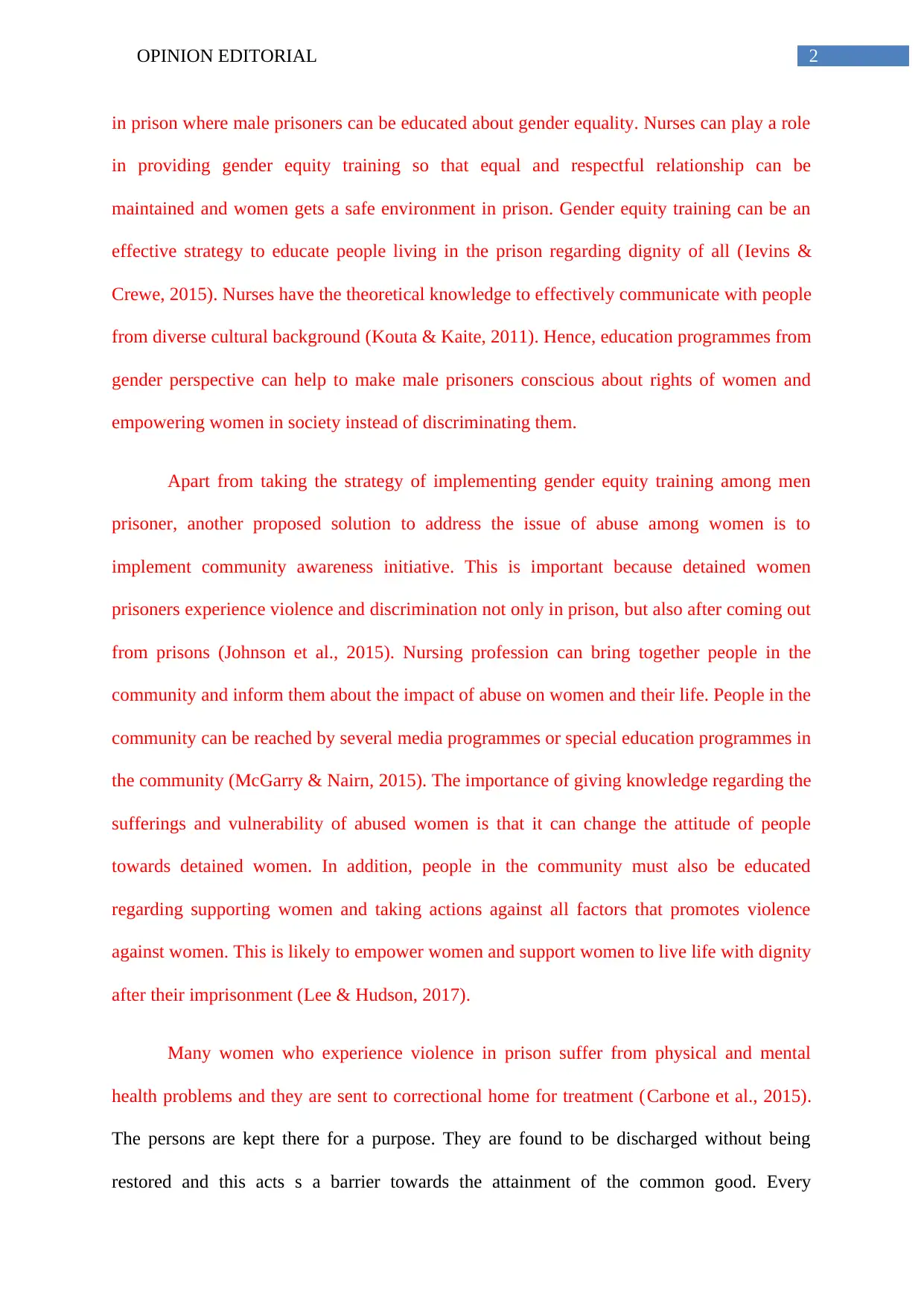
2OPINION EDITORIAL
in prison where male prisoners can be educated about gender equality. Nurses can play a role
in providing gender equity training so that equal and respectful relationship can be
maintained and women gets a safe environment in prison. Gender equity training can be an
effective strategy to educate people living in the prison regarding dignity of all (Ievins &
Crewe, 2015). Nurses have the theoretical knowledge to effectively communicate with people
from diverse cultural background (Kouta & Kaite, 2011). Hence, education programmes from
gender perspective can help to make male prisoners conscious about rights of women and
empowering women in society instead of discriminating them.
Apart from taking the strategy of implementing gender equity training among men
prisoner, another proposed solution to address the issue of abuse among women is to
implement community awareness initiative. This is important because detained women
prisoners experience violence and discrimination not only in prison, but also after coming out
from prisons (Johnson et al., 2015). Nursing profession can bring together people in the
community and inform them about the impact of abuse on women and their life. People in the
community can be reached by several media programmes or special education programmes in
the community (McGarry & Nairn, 2015). The importance of giving knowledge regarding the
sufferings and vulnerability of abused women is that it can change the attitude of people
towards detained women. In addition, people in the community must also be educated
regarding supporting women and taking actions against all factors that promotes violence
against women. This is likely to empower women and support women to live life with dignity
after their imprisonment (Lee & Hudson, 2017).
Many women who experience violence in prison suffer from physical and mental
health problems and they are sent to correctional home for treatment (Carbone et al., 2015).
The persons are kept there for a purpose. They are found to be discharged without being
restored and this acts s a barrier towards the attainment of the common good. Every
in prison where male prisoners can be educated about gender equality. Nurses can play a role
in providing gender equity training so that equal and respectful relationship can be
maintained and women gets a safe environment in prison. Gender equity training can be an
effective strategy to educate people living in the prison regarding dignity of all (Ievins &
Crewe, 2015). Nurses have the theoretical knowledge to effectively communicate with people
from diverse cultural background (Kouta & Kaite, 2011). Hence, education programmes from
gender perspective can help to make male prisoners conscious about rights of women and
empowering women in society instead of discriminating them.
Apart from taking the strategy of implementing gender equity training among men
prisoner, another proposed solution to address the issue of abuse among women is to
implement community awareness initiative. This is important because detained women
prisoners experience violence and discrimination not only in prison, but also after coming out
from prisons (Johnson et al., 2015). Nursing profession can bring together people in the
community and inform them about the impact of abuse on women and their life. People in the
community can be reached by several media programmes or special education programmes in
the community (McGarry & Nairn, 2015). The importance of giving knowledge regarding the
sufferings and vulnerability of abused women is that it can change the attitude of people
towards detained women. In addition, people in the community must also be educated
regarding supporting women and taking actions against all factors that promotes violence
against women. This is likely to empower women and support women to live life with dignity
after their imprisonment (Lee & Hudson, 2017).
Many women who experience violence in prison suffer from physical and mental
health problems and they are sent to correctional home for treatment (Carbone et al., 2015).
The persons are kept there for a purpose. They are found to be discharged without being
restored and this acts s a barrier towards the attainment of the common good. Every
⊘ This is a preview!⊘
Do you want full access?
Subscribe today to unlock all pages.

Trusted by 1+ million students worldwide
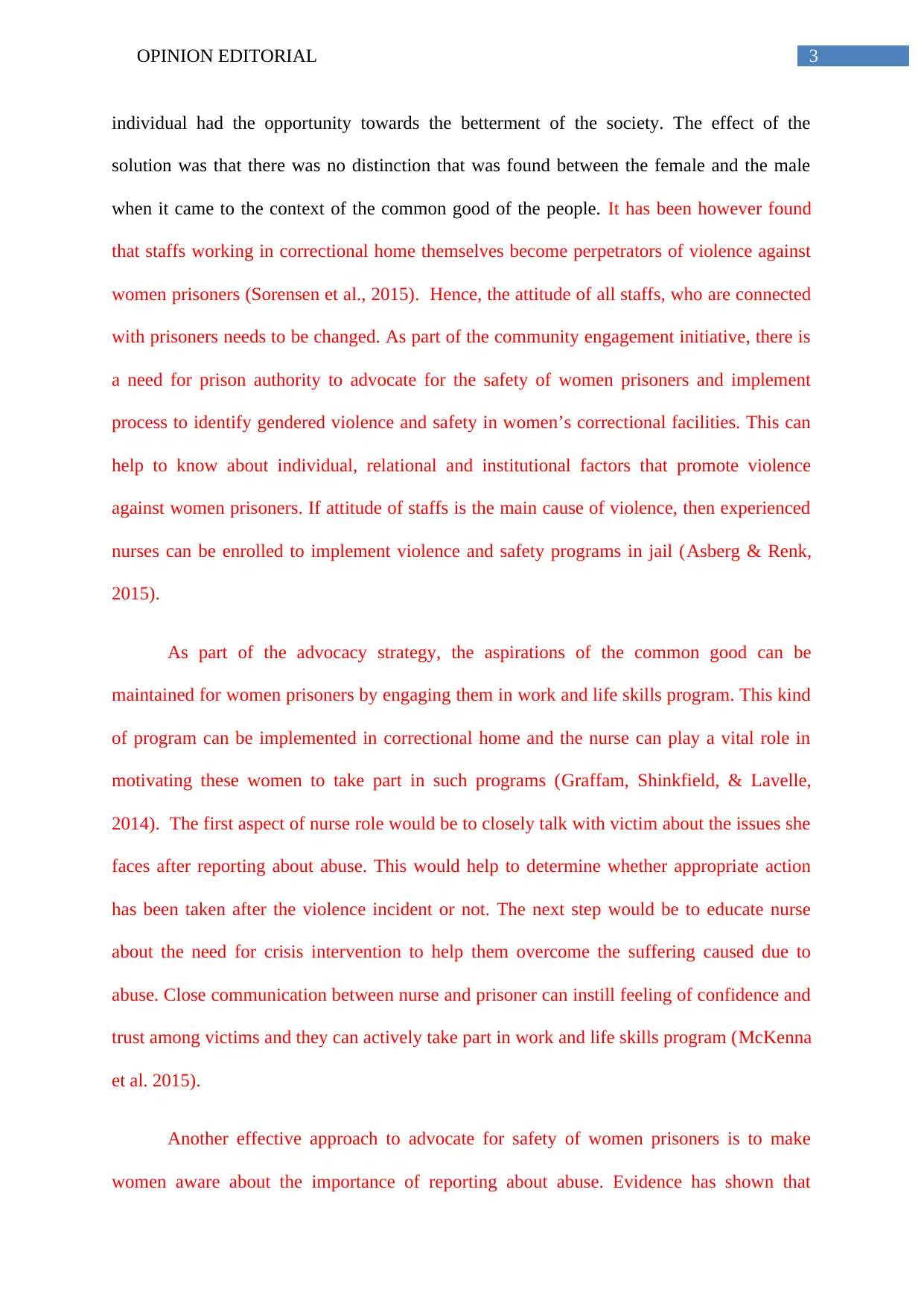
3OPINION EDITORIAL
individual had the opportunity towards the betterment of the society. The effect of the
solution was that there was no distinction that was found between the female and the male
when it came to the context of the common good of the people. It has been however found
that staffs working in correctional home themselves become perpetrators of violence against
women prisoners (Sorensen et al., 2015). Hence, the attitude of all staffs, who are connected
with prisoners needs to be changed. As part of the community engagement initiative, there is
a need for prison authority to advocate for the safety of women prisoners and implement
process to identify gendered violence and safety in women’s correctional facilities. This can
help to know about individual, relational and institutional factors that promote violence
against women prisoners. If attitude of staffs is the main cause of violence, then experienced
nurses can be enrolled to implement violence and safety programs in jail (Asberg & Renk,
2015).
As part of the advocacy strategy, the aspirations of the common good can be
maintained for women prisoners by engaging them in work and life skills program. This kind
of program can be implemented in correctional home and the nurse can play a vital role in
motivating these women to take part in such programs (Graffam, Shinkfield, & Lavelle,
2014). The first aspect of nurse role would be to closely talk with victim about the issues she
faces after reporting about abuse. This would help to determine whether appropriate action
has been taken after the violence incident or not. The next step would be to educate nurse
about the need for crisis intervention to help them overcome the suffering caused due to
abuse. Close communication between nurse and prisoner can instill feeling of confidence and
trust among victims and they can actively take part in work and life skills program (McKenna
et al. 2015).
Another effective approach to advocate for safety of women prisoners is to make
women aware about the importance of reporting about abuse. Evidence has shown that
individual had the opportunity towards the betterment of the society. The effect of the
solution was that there was no distinction that was found between the female and the male
when it came to the context of the common good of the people. It has been however found
that staffs working in correctional home themselves become perpetrators of violence against
women prisoners (Sorensen et al., 2015). Hence, the attitude of all staffs, who are connected
with prisoners needs to be changed. As part of the community engagement initiative, there is
a need for prison authority to advocate for the safety of women prisoners and implement
process to identify gendered violence and safety in women’s correctional facilities. This can
help to know about individual, relational and institutional factors that promote violence
against women prisoners. If attitude of staffs is the main cause of violence, then experienced
nurses can be enrolled to implement violence and safety programs in jail (Asberg & Renk,
2015).
As part of the advocacy strategy, the aspirations of the common good can be
maintained for women prisoners by engaging them in work and life skills program. This kind
of program can be implemented in correctional home and the nurse can play a vital role in
motivating these women to take part in such programs (Graffam, Shinkfield, & Lavelle,
2014). The first aspect of nurse role would be to closely talk with victim about the issues she
faces after reporting about abuse. This would help to determine whether appropriate action
has been taken after the violence incident or not. The next step would be to educate nurse
about the need for crisis intervention to help them overcome the suffering caused due to
abuse. Close communication between nurse and prisoner can instill feeling of confidence and
trust among victims and they can actively take part in work and life skills program (McKenna
et al. 2015).
Another effective approach to advocate for safety of women prisoners is to make
women aware about the importance of reporting about abuse. Evidence has shown that
Paraphrase This Document
Need a fresh take? Get an instant paraphrase of this document with our AI Paraphraser
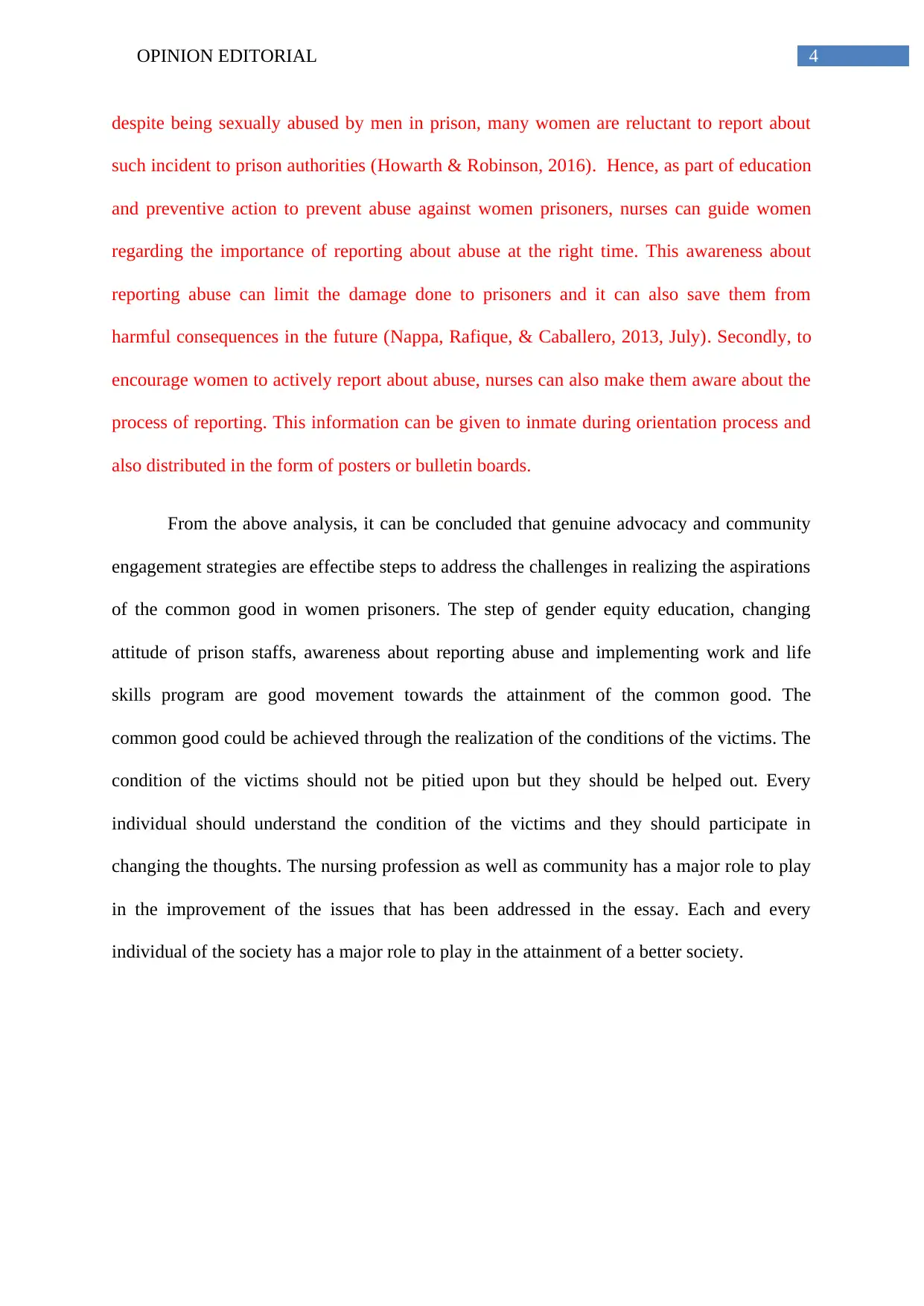
4OPINION EDITORIAL
despite being sexually abused by men in prison, many women are reluctant to report about
such incident to prison authorities (Howarth & Robinson, 2016). Hence, as part of education
and preventive action to prevent abuse against women prisoners, nurses can guide women
regarding the importance of reporting about abuse at the right time. This awareness about
reporting abuse can limit the damage done to prisoners and it can also save them from
harmful consequences in the future (Nappa, Rafique, & Caballero, 2013, July). Secondly, to
encourage women to actively report about abuse, nurses can also make them aware about the
process of reporting. This information can be given to inmate during orientation process and
also distributed in the form of posters or bulletin boards.
From the above analysis, it can be concluded that genuine advocacy and community
engagement strategies are effectibe steps to address the challenges in realizing the aspirations
of the common good in women prisoners. The step of gender equity education, changing
attitude of prison staffs, awareness about reporting abuse and implementing work and life
skills program are good movement towards the attainment of the common good. The
common good could be achieved through the realization of the conditions of the victims. The
condition of the victims should not be pitied upon but they should be helped out. Every
individual should understand the condition of the victims and they should participate in
changing the thoughts. The nursing profession as well as community has a major role to play
in the improvement of the issues that has been addressed in the essay. Each and every
individual of the society has a major role to play in the attainment of a better society.
despite being sexually abused by men in prison, many women are reluctant to report about
such incident to prison authorities (Howarth & Robinson, 2016). Hence, as part of education
and preventive action to prevent abuse against women prisoners, nurses can guide women
regarding the importance of reporting about abuse at the right time. This awareness about
reporting abuse can limit the damage done to prisoners and it can also save them from
harmful consequences in the future (Nappa, Rafique, & Caballero, 2013, July). Secondly, to
encourage women to actively report about abuse, nurses can also make them aware about the
process of reporting. This information can be given to inmate during orientation process and
also distributed in the form of posters or bulletin boards.
From the above analysis, it can be concluded that genuine advocacy and community
engagement strategies are effectibe steps to address the challenges in realizing the aspirations
of the common good in women prisoners. The step of gender equity education, changing
attitude of prison staffs, awareness about reporting abuse and implementing work and life
skills program are good movement towards the attainment of the common good. The
common good could be achieved through the realization of the conditions of the victims. The
condition of the victims should not be pitied upon but they should be helped out. Every
individual should understand the condition of the victims and they should participate in
changing the thoughts. The nursing profession as well as community has a major role to play
in the improvement of the issues that has been addressed in the essay. Each and every
individual of the society has a major role to play in the attainment of a better society.
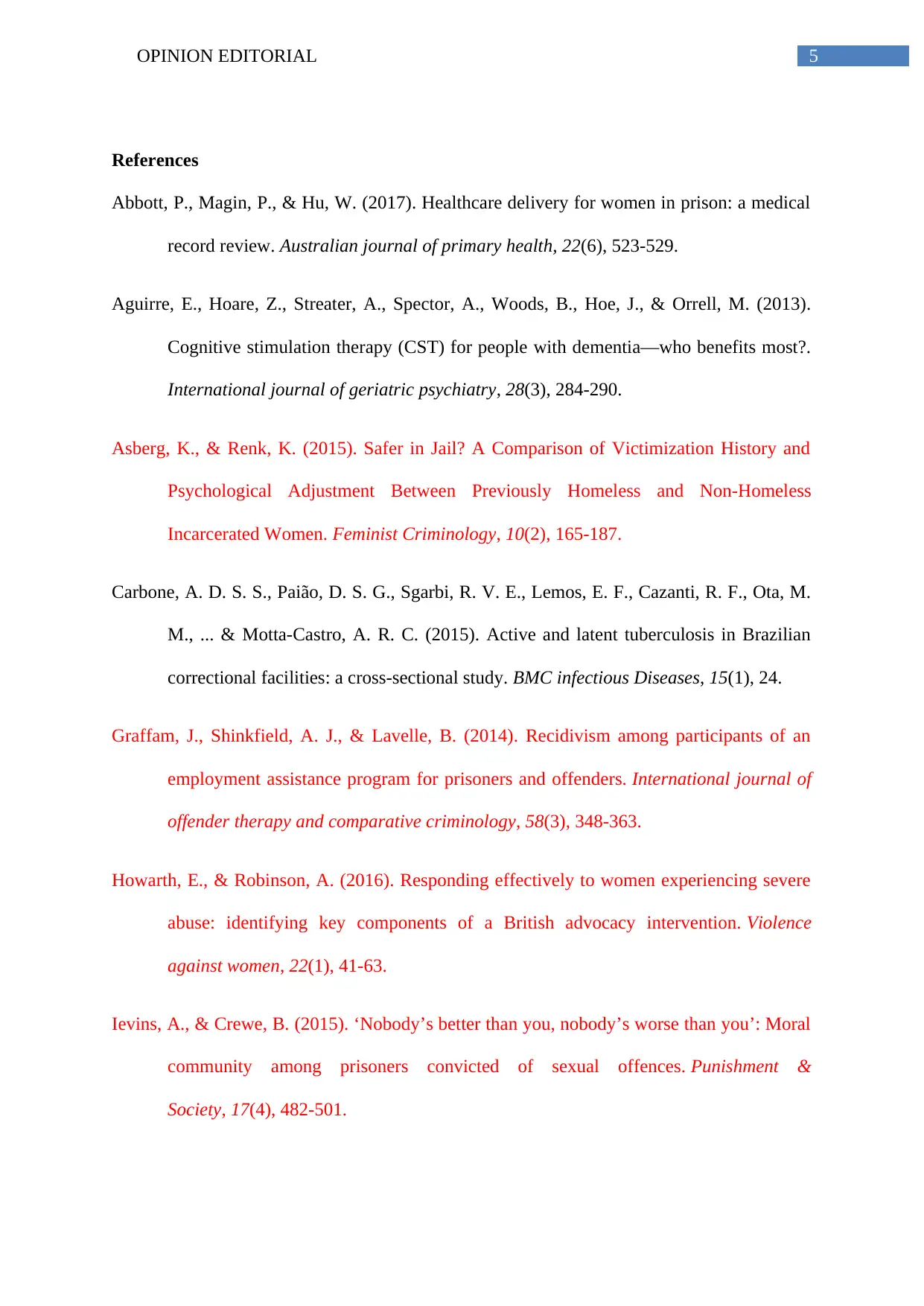
5OPINION EDITORIAL
References
Abbott, P., Magin, P., & Hu, W. (2017). Healthcare delivery for women in prison: a medical
record review. Australian journal of primary health, 22(6), 523-529.
Aguirre, E., Hoare, Z., Streater, A., Spector, A., Woods, B., Hoe, J., & Orrell, M. (2013).
Cognitive stimulation therapy (CST) for people with dementia—who benefits most?.
International journal of geriatric psychiatry, 28(3), 284-290.
Asberg, K., & Renk, K. (2015). Safer in Jail? A Comparison of Victimization History and
Psychological Adjustment Between Previously Homeless and Non-Homeless
Incarcerated Women. Feminist Criminology, 10(2), 165-187.
Carbone, A. D. S. S., Paião, D. S. G., Sgarbi, R. V. E., Lemos, E. F., Cazanti, R. F., Ota, M.
M., ... & Motta-Castro, A. R. C. (2015). Active and latent tuberculosis in Brazilian
correctional facilities: a cross-sectional study. BMC infectious Diseases, 15(1), 24.
Graffam, J., Shinkfield, A. J., & Lavelle, B. (2014). Recidivism among participants of an
employment assistance program for prisoners and offenders. International journal of
offender therapy and comparative criminology, 58(3), 348-363.
Howarth, E., & Robinson, A. (2016). Responding effectively to women experiencing severe
abuse: identifying key components of a British advocacy intervention. Violence
against women, 22(1), 41-63.
Ievins, A., & Crewe, B. (2015). ‘Nobody’s better than you, nobody’s worse than you’: Moral
community among prisoners convicted of sexual offences. Punishment &
Society, 17(4), 482-501.
References
Abbott, P., Magin, P., & Hu, W. (2017). Healthcare delivery for women in prison: a medical
record review. Australian journal of primary health, 22(6), 523-529.
Aguirre, E., Hoare, Z., Streater, A., Spector, A., Woods, B., Hoe, J., & Orrell, M. (2013).
Cognitive stimulation therapy (CST) for people with dementia—who benefits most?.
International journal of geriatric psychiatry, 28(3), 284-290.
Asberg, K., & Renk, K. (2015). Safer in Jail? A Comparison of Victimization History and
Psychological Adjustment Between Previously Homeless and Non-Homeless
Incarcerated Women. Feminist Criminology, 10(2), 165-187.
Carbone, A. D. S. S., Paião, D. S. G., Sgarbi, R. V. E., Lemos, E. F., Cazanti, R. F., Ota, M.
M., ... & Motta-Castro, A. R. C. (2015). Active and latent tuberculosis in Brazilian
correctional facilities: a cross-sectional study. BMC infectious Diseases, 15(1), 24.
Graffam, J., Shinkfield, A. J., & Lavelle, B. (2014). Recidivism among participants of an
employment assistance program for prisoners and offenders. International journal of
offender therapy and comparative criminology, 58(3), 348-363.
Howarth, E., & Robinson, A. (2016). Responding effectively to women experiencing severe
abuse: identifying key components of a British advocacy intervention. Violence
against women, 22(1), 41-63.
Ievins, A., & Crewe, B. (2015). ‘Nobody’s better than you, nobody’s worse than you’: Moral
community among prisoners convicted of sexual offences. Punishment &
Society, 17(4), 482-501.
⊘ This is a preview!⊘
Do you want full access?
Subscribe today to unlock all pages.

Trusted by 1+ million students worldwide
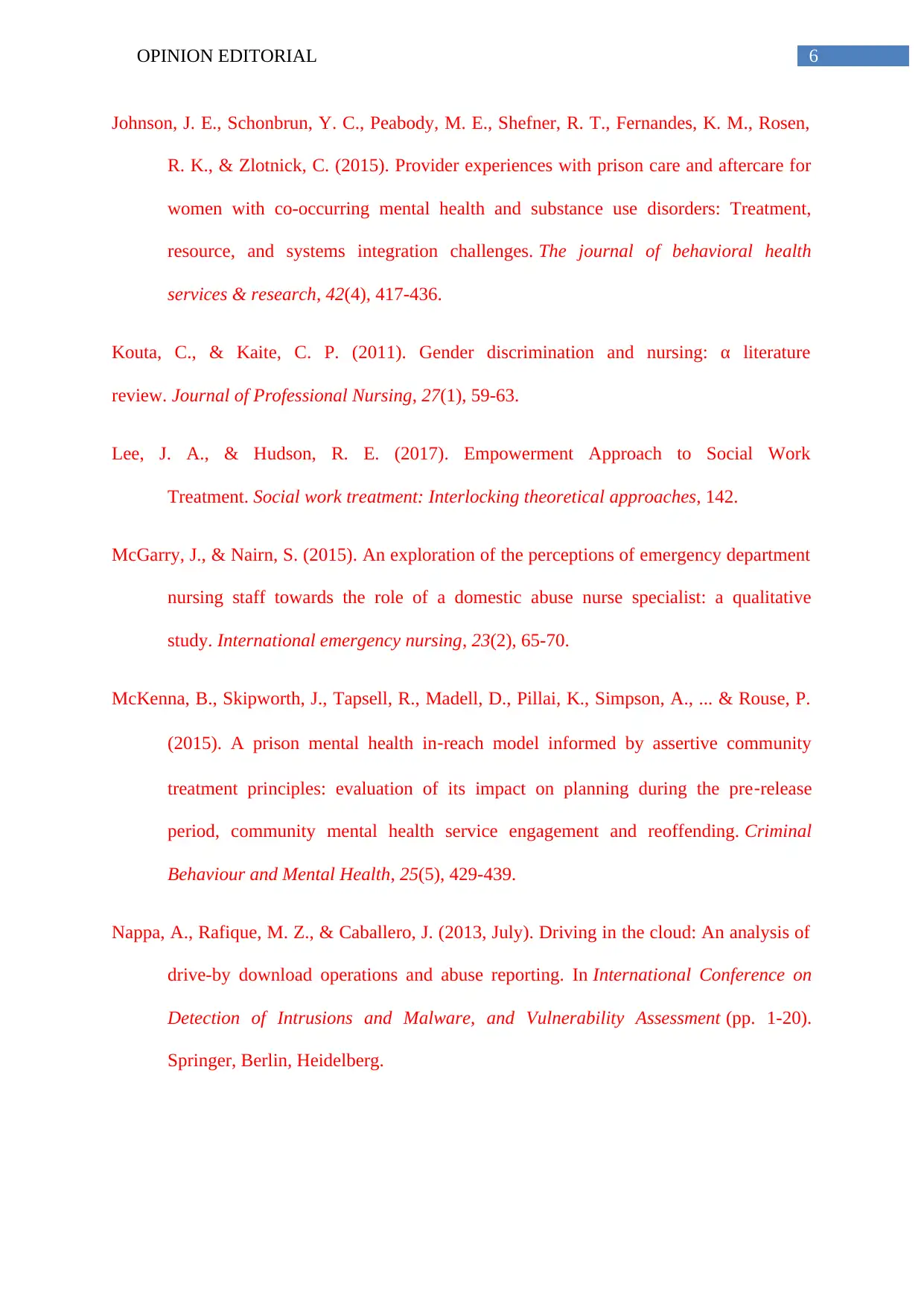
6OPINION EDITORIAL
Johnson, J. E., Schonbrun, Y. C., Peabody, M. E., Shefner, R. T., Fernandes, K. M., Rosen,
R. K., & Zlotnick, C. (2015). Provider experiences with prison care and aftercare for
women with co-occurring mental health and substance use disorders: Treatment,
resource, and systems integration challenges. The journal of behavioral health
services & research, 42(4), 417-436.
Kouta, C., & Kaite, C. P. (2011). Gender discrimination and nursing: α literature
review. Journal of Professional Nursing, 27(1), 59-63.
Lee, J. A., & Hudson, R. E. (2017). Empowerment Approach to Social Work
Treatment. Social work treatment: Interlocking theoretical approaches, 142.
McGarry, J., & Nairn, S. (2015). An exploration of the perceptions of emergency department
nursing staff towards the role of a domestic abuse nurse specialist: a qualitative
study. International emergency nursing, 23(2), 65-70.
McKenna, B., Skipworth, J., Tapsell, R., Madell, D., Pillai, K., Simpson, A., ... & Rouse, P.
(2015). A prison mental health in‐reach model informed by assertive community
treatment principles: evaluation of its impact on planning during the pre‐release
period, community mental health service engagement and reoffending. Criminal
Behaviour and Mental Health, 25(5), 429-439.
Nappa, A., Rafique, M. Z., & Caballero, J. (2013, July). Driving in the cloud: An analysis of
drive-by download operations and abuse reporting. In International Conference on
Detection of Intrusions and Malware, and Vulnerability Assessment (pp. 1-20).
Springer, Berlin, Heidelberg.
Johnson, J. E., Schonbrun, Y. C., Peabody, M. E., Shefner, R. T., Fernandes, K. M., Rosen,
R. K., & Zlotnick, C. (2015). Provider experiences with prison care and aftercare for
women with co-occurring mental health and substance use disorders: Treatment,
resource, and systems integration challenges. The journal of behavioral health
services & research, 42(4), 417-436.
Kouta, C., & Kaite, C. P. (2011). Gender discrimination and nursing: α literature
review. Journal of Professional Nursing, 27(1), 59-63.
Lee, J. A., & Hudson, R. E. (2017). Empowerment Approach to Social Work
Treatment. Social work treatment: Interlocking theoretical approaches, 142.
McGarry, J., & Nairn, S. (2015). An exploration of the perceptions of emergency department
nursing staff towards the role of a domestic abuse nurse specialist: a qualitative
study. International emergency nursing, 23(2), 65-70.
McKenna, B., Skipworth, J., Tapsell, R., Madell, D., Pillai, K., Simpson, A., ... & Rouse, P.
(2015). A prison mental health in‐reach model informed by assertive community
treatment principles: evaluation of its impact on planning during the pre‐release
period, community mental health service engagement and reoffending. Criminal
Behaviour and Mental Health, 25(5), 429-439.
Nappa, A., Rafique, M. Z., & Caballero, J. (2013, July). Driving in the cloud: An analysis of
drive-by download operations and abuse reporting. In International Conference on
Detection of Intrusions and Malware, and Vulnerability Assessment (pp. 1-20).
Springer, Berlin, Heidelberg.
Paraphrase This Document
Need a fresh take? Get an instant paraphrase of this document with our AI Paraphraser
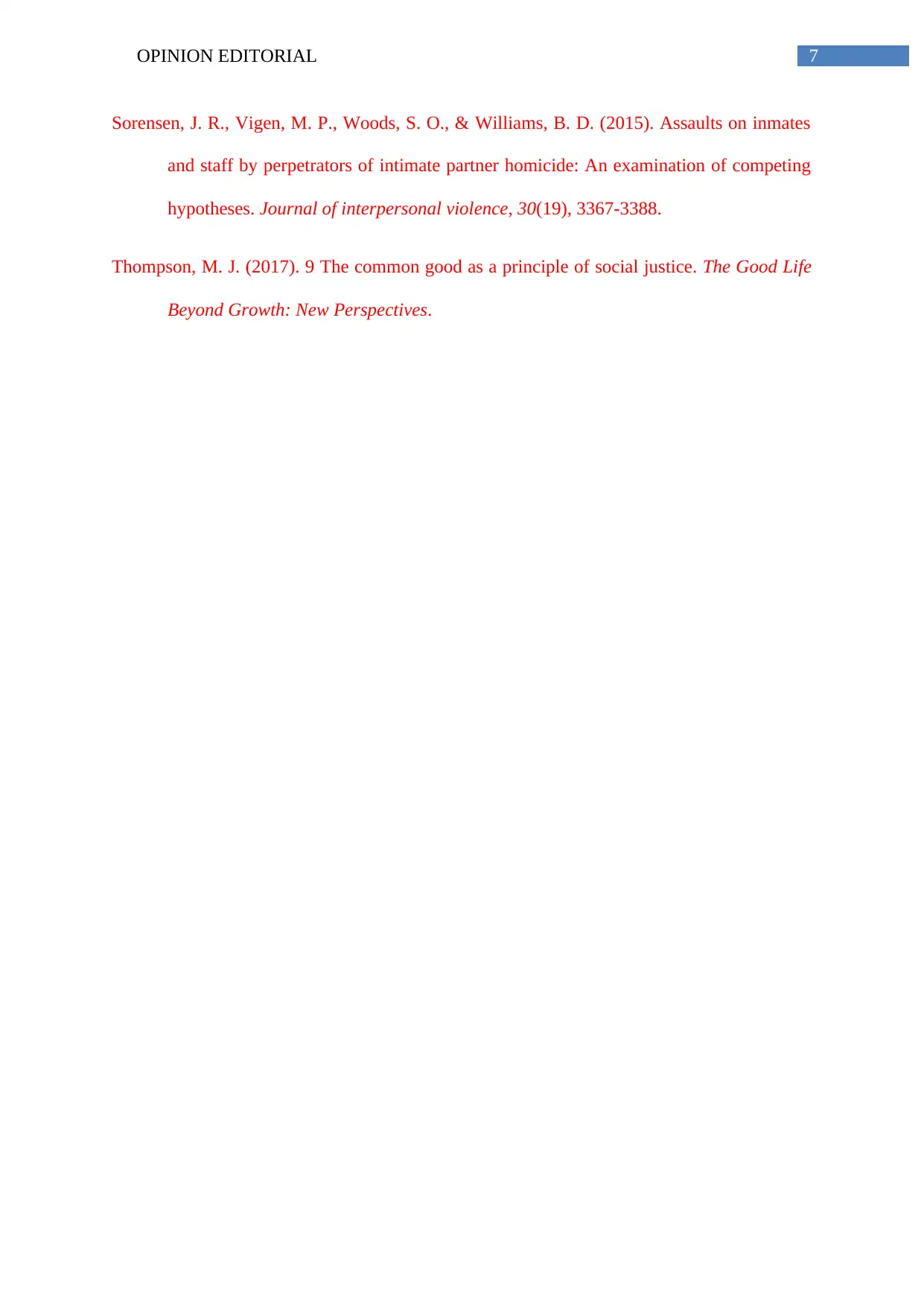
7OPINION EDITORIAL
Sorensen, J. R., Vigen, M. P., Woods, S. O., & Williams, B. D. (2015). Assaults on inmates
and staff by perpetrators of intimate partner homicide: An examination of competing
hypotheses. Journal of interpersonal violence, 30(19), 3367-3388.
Thompson, M. J. (2017). 9 The common good as a principle of social justice. The Good Life
Beyond Growth: New Perspectives.
Sorensen, J. R., Vigen, M. P., Woods, S. O., & Williams, B. D. (2015). Assaults on inmates
and staff by perpetrators of intimate partner homicide: An examination of competing
hypotheses. Journal of interpersonal violence, 30(19), 3367-3388.
Thompson, M. J. (2017). 9 The common good as a principle of social justice. The Good Life
Beyond Growth: New Perspectives.
1 out of 8
Related Documents
Your All-in-One AI-Powered Toolkit for Academic Success.
+13062052269
info@desklib.com
Available 24*7 on WhatsApp / Email
![[object Object]](/_next/static/media/star-bottom.7253800d.svg)
Unlock your academic potential
Copyright © 2020–2025 A2Z Services. All Rights Reserved. Developed and managed by ZUCOL.





